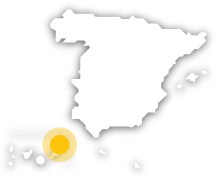
Lanzarote Biosphere Reserve

A volcanic paradise
The perfect way in which Lanzarote has managed to integrate its tourist infrastructure within the island's natural environment make it a model of sustainability for the rest of the world.
Lanzarote, the easternmost of all the Canary Islands, is characterised by a unique volcanic landscape marked by stunning geological formations. However, it is far from appearing barren. In fact, it is a gorgeous example of a volcanic ecosystem, which earned the island the title of Biosphere Reserve. If something defines Lanzarote, it is its peculiar landscape of lava and volcanic ash, the result of the various volcanic eruptions that took place in the island between the 18th and the 19th centuries. From north to south, the island exhibits a varied scenery, from the luxurious vegetation found in Haría to the vineyards in La Geria. Along the coastline there are beautiful beaches like Papagayo and Famara, which contrast with the rocky cliffs and volcanic formations found in places like Los Hervideros and El Golfo. The most intense seismic activity was registered in the Timanfaya National Park, a veritable showcase of the island's ecosystem. This space comprises an immense sea of solidified lava, in which very curious geologic formations emerge, like grottoes, cones and craters. In this peculiar landscape, a diverse flora is concealed, including rushes and shrubs like the hollyhock, the dandelion, the spurge and the Forsskaolea angustifolia. We also find many different species of lichens. Lanzarote has some other open spaces of great importance, such as the Los Volcanes Nature Park, which surrounds Timanfaya, and the Archipelago Chinijo Nature Park, a marine ecosystem that comprises gorgeous isles, inhabited by numerous bird species. The perfect way in which Lanzarote has managed to integrate its tourist infrastructure within the island's natural environment make it a model of sustainability for the rest of the world. This fact, along with the excellent state of preservation of its natural heritage, lead to the declaration of the island as a Biosphere Reserve in 1993.
Lanzarote Biosphere Reserve
Lanzarote (Canary Islands)
Activa JS
What you need to know
-
Cultural information
The island also has some very interesting towns. In addition to Arrecife, its capital city, Teguise, San Bartolomé and Tinajo are worth noting. Lanzarote's coastline is lined with beautiful beaches and important tourist centres, like Costa Teguise, Blanca Beach and Puerto del Carmen. Another feature of the island is an attractive collection of spaces designed by local architect César Manrique, which include Jameos del Agua, the garden of Cactus and the foundation that bears his name.
-
Environmental information
Lanzarote's great biodiversity is in part due to the island's volcanic origin. In Timanfaya alone, 180 different plant species have been accounted for. As for the fauna, some endemic reptiles can be found, such as the Atlantic lizard and the Eastern Canarian gecko (Tarentola angustimentalis).
-
Information for visits
Lanzarote is very well connected by air and by sea. Daily flights connecting the island with Gran Canaria, Tenerife and the Iberian Peninsula depart from the airport located in Arrecife. Likewise, it is connected by boat with all the main islands in the archipelago.
Travel plans for inspiring you



